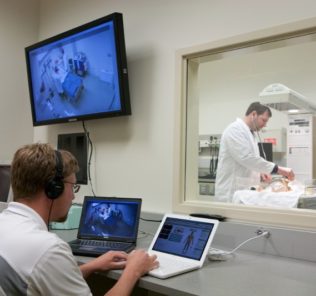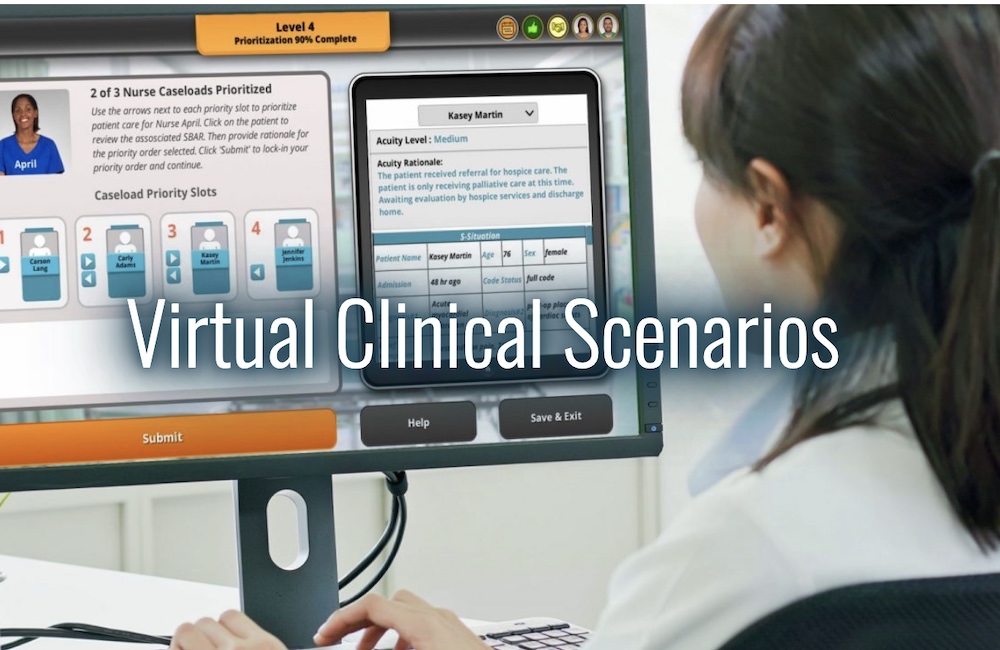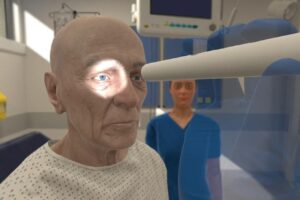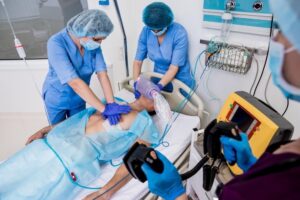Leveling Up on Prelicensure Learners Telehealth Healthcare Simulations
Clinical simulation education and training have proven to greatly increase patient safety across medical treatment facilities. For this to happen, prelicensure baccalaureate nursing learners must receive skills training and competency check-offs to ensure adequate care of patients as they continue through the curricula. To certify that these skills are met, nursing learners are typically evaluated based on the National League of Nursing (NLN) and/or QSEN competencies at clinical sites. Much of their learning is reinforced through healthcare simulation-based experiences (SBEs), nursing simulation-based experiences may focus on a variety of topics and actions such as interventions, skills, and therapeutic communication.
Healthcare simulation training for assessing telehealth capacity in various levels must first include traditional teaching, classroom or virtual, and knowledge assessments. To enhance access to healthcare, innovative technologies, such as telehealth, and telemedicine, have become more important in managing patient care at a distance; especially important in those with little or no access to healthcare, a current public health crisis. Nursing programs need to answer this call, in innovation and incorporate educational training strategies to reflect this transformation.
Educators have a duty to provide learners with various assessment tools and modalities. Examples include asking the right questions during every assessment, not only to report physical findings but now, how to obtain the same information over the telephone or videoconference. This article, written by TIffani Chidume, DNP, RN, CCRN-K, CHSE, CHSOS, details how these efforts can strengthen healthcare access through telehealth by providing learners with telehealth-specific knowledge and training as they are learning the practice of promoting and protecting the health of numerous populations.
Sponsored Content:
Telehealth Versus Telemedicine
There are various definitions of telehealth, which may be used synonymously with telemedicine, but they are in fact, different. Telehealth, as defined by the American Academy of Family Physicians (AAFP) is the utilization of electronic information and telecommunication technologies to provide patient care from a distance, including wireless communication, videoconferencing, and store-and-forward options (AAFP, 2021). Telemedicine refers to practicing medicine utilizing technology to provide distance care (AAFP, 2021). In short, though both are remote and completed from a distance, telehealth can describe non-clinical services, whereas telemedicine describes clinical services.
Both increase access to healthcare in various populations, but often, those with limited access to healthcare also have limited access to the technologies that make telehealth and telemedicine possible, such as computers, smart devices, and internet service. Optimally, one would have a face-to-face encounter with the healthcare provider. The number of individuals with limited access to healthcare is steadily increasing and the COVID-19 pandemic has worsened the situation, whether it be related to the closing of healthcare provider waiting rooms and offices, to individuals not going out as much in attempts to stay healthy and away from possible exposures to the coronavirus, influenza, rhinovirus, and more.
Daly (2020) also predicts that post-COVID telehealth visits will continue by ~30-40%, based on a national survey by The Harris Poll. For the purposes of this article, “telehealth” will be used since prelicensure baccalaureate nursing students are not yet credentialed to provide clinical services.
Sponsored Content:
Healthcare Simulation and Telehealth
Medical simulation-based experiences incorporating telehealth will provide much-needed practice and experiences to enhance students’ confidence and knowledge in providing care for those with limited access to healthcare. Providing various learning opportunities also aids in the learners’ ability to understand and provide telehealth options. Smith, Watts, and Moss (2018) found that “simulation provided students [learners] with the opportunity to demonstrate the use of telehealth equipment and become familiar with telehealth” when using simulation to teach telehealth nursing competencies. Healthcare simulations with a telehealth component can be designed and implemented at various nursing education levels and range in complexity.
The simplest integration of telehealth simulation-based scenarios can be a telephone call with a healthcare provider but usually refers to some type of communication with video or transference of healthcare information. An example for prelicensure baccalaureate nursing learners could be a telephone or video triage call from a simulated or standardized patient (SPs). The SP could be relaying or demonstrating symptoms of a disease process or illness and the objective for the learner would be to obtain a thorough history of present illness.
This could also be a dual-objective SBE where the learner must communicate first with the patient and the second objective would be to convey the findings to the physician, either via phone or videoconference. A component of the learner evaluation should include if information, such as how and where to call if symptoms worsen. Some facilities have even incorporated secure messaging texts, which are HIPPA safe, between nurses, physicians, and other members of the healthcare team.
More complex healthcare simulations utilizing a telehealth component may be developed for advanced practice registered nursing education. A group of nursing educators and researchers recently developed the iSOAP tool, which includes a model for developing telehealth simulations as well as an evaluation checklist for learners (Chike-Harris et al., 2021). The iSOAP tool accounts for the usual SOAP note components of subjective, objective, assessment, and planning, with the addition of an introductory section to begin the session (Chike-Harris et al., 2021).
Leveling up on the example in the previous paragraph, advanced practice registered nurses (APRNs) could still be members of the healthcare team gathering information on the patient’s (SPs) signs and symptoms. However, APRNs can diagnose and prescribe medications and follow up with the patients at a later time…which could lead to the development of two possible SBEs. The first evaluates the competence of the APRN regarding the diagnosis, treatment, and overall care of the distanced patient and the second evaluates the development of a suitable follow-up time (would depend on diagnosis) with appropriate follow-up questions for the patient.
Depending on the level of the learner, telehealth simulation options are endless. To date and across various levels, telehealth simulations have been developed focusing on neonatal care, diabetes treatment, psychiatry, chronic disease comorbidities, women’s health, and many more. Further, telehealth simulations may be utilized to collaborate with other health professions and improve communication, both interdisciplinary and interprofessional.
Learn More About Telesimulation
-
- American Academy of Family Physicians (AAFP). (2021). What’s the difference between telemedicine and telehealth? Retrieved from https://www.aafp.org/news/media-center/kits/telemedicine-and-telehealth.html
- Chike-Harris, K. E., LaManna, J. B., Eckhoff, D. O., Buchanan, L., McCumber, S., Corcoran, K. J., Shea, J. M., & Rutledge, C. M. (2021). The Missing Link: The iSOAP Model for Incorporating Telehealth Within Simulations. Clinical Simulation in Nursing, 59, 39–51. https://doi-org.spot.lib.auburn.edu/10.1016/j.ecns.2021.05.006
- Daly, R. (2020). Consumers expect expanded telehealth to remain post-COVID-19, survey finds. Retrieved from https://www.hfma.org/topics/news/2020/07/consumers-expect-expanded-telehealth-to-remain-post-covid-19--su.html
- Smith T., Watts, P., and Moss, J. (2018). Using simulation to teach telehealth nursing competencies. Journal of Nursing Education, 57(10). https://doi.org/10.3928/01484834-20180921-10
Dr. Tiffani Chidume is an associate clinical professor simulation center coordinator at the Auburn University College of Nursing. She has 22 years of combined experience in nursing education, simulation methodology, critical care, emergency nursing, long-term healthcare, and health information technology. Dr. Chidume is dual certified in simulation as a Certified Healthcare Simulation Educator-Advanced (CHSE-A) and as Certified Healthcare Simulation Operations Specialist (CHSOS).
Sponsored Content:



















